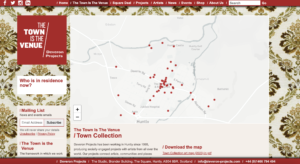As the city-centric art world increasingly looks to the margins, rural curating is no longer a trend, but a necessary reconfiguration of our understanding of space, labor, community, and art itself. My curatorial project, held in a traditional rural house in Yudong Village, China, seeks to facilitate this shift by using daily life—its rhythms, aesthetics, and material culture—as a curatorial language in itself.
⸻
House as Exhibition: Repositioning Domestic Space as Art Site
The domestic scene in the exhibition—kitchen, living room, staircase—is not neutral; it is imbued with cultural, gendered, and labor histories. As Miwon Kwon (2002) argues in Places by Places, site-specificity is no longer simply about location, but about layers of social meaning and lived interactions. In this sense, the exhibition at Yudong house is not just about “being” in the village, but about co-presenting with the rhythms of the village—from the smell of firewood to the collaborative touch of bamboo weaving.
Some international projects echo this line of thought: the Deveron Projects Town Collection in Huntly, Scotland, integrates commissioned artworks into the town’s everyday landscape, embedding art into social structures rather than isolating it in institutional spaces. Similarly, Jatiwangi Art Factory in Indonesia, a collective and lumbung member of Documenta 15 in Kassel, reinterpreted rural narratives through clay-based practices and community production, turning villages into bearers and creators of cultural meaning.

Town Collection Website
⸻
From spectator to co-creator: participatory and relational models
The project also draws on the participatory curatorial model (Bishop, 2012; Simon, 2010), in which the boundaries between spectators and creators are dissolved. The villagers are not the “subjects” of the exhibition—they are guides, narrators, artists, and vendors. In the kitchen, paintings on the stove sparked discussions about farming memories; in the courtyard, local handicrafts were not only sold, but also displayed and discussed. These interactions embody what Nicolas Bourriaud coined in 2002 as “relational aesthetics”: art is defined by relationships, co-presence, and the potential for co-transformation.
The work of Myvillages offers a particularly resonant model. Their long-standing village-centric projects, such as International Village Shop or Farm Painting, redefine how cultural production can emerge from local knowledge systems rather than be imported from the outside. Their manifesto-like approach challenges the dominance of urban culture by affirming rural knowledge as contemporary art.
⸻
Rural Time
Curating in the countryside also requires a shift in rhythm and epistemology. As laid out in Curating in the Countryside by the University of Edinburgh, it rejects spectacle in favor of slowness, embeddedness, and reciprocity. It emphasizes knowledge constructed through proximity rather than concepts. In Yudong, curating unfolds not only through selection but also through dialogue, shared dining, and co-presence, echoing the “Lembang principle” of sustainability and resource sharing.
⸻
Conclusion
This project explores: What happens when exhibitions are not brought to the village, but born from the village? When art is no longer an intervention, but a continuation? Through family-based, labor-integrated, relationship-driven curation, we begin to understand that rural space is not just a place, but also a strategy and a theme.
⸻


Leave a Reply